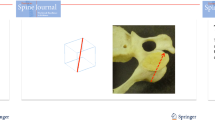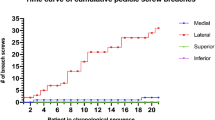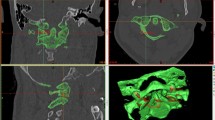Abstract
Background: Various lateral mass screw fixation methods have been described in the literature with various levels of safety in relation to the anterior neurovascular structures. This study was designed to radiologically determine the minimum lateral angulations of the screw to avoid penetration of the vertebral artery canalusing three of the most common techniques: Roy-Camille, An, and Magerl.
Materials and Methods: Sixty normal cervical CT scans were reviewed. A minimum lateral angulation of a 3.5 mm lateral mass screw which was required to avoid penetration of the vertebral artery canal at each level of vertebra were measured.
Results: The mean lateral angulations of the lateral mass screws (with 95% confidence interval) to avoid vertebral artery canal penetration, in relation to the starting point at the midpoint (Roy-Camille), 1 mm medial (An), and 2 mm medial (Magerl) to the midpoint of lateral mass were 6.8° (range, 6.3–7.4°), 10.3° (range, 9.8–10.8°), and 14.1° (range, 13.6–14.6°) at C3 vertebrae; 6.8° (range, 6.2–7.5°), 10.7° (range, 10.0–11.5°), and 14.1° (range, 13.4–14.8°) at C4 vertebrae; 6.6° (range, 6.0–7.2°), 10.1° (range, 9.3–10.8°), and 13.5° (range, 12.8–14.3°) at C5 vertebrae and 7.6° (range, 6.9–8.3°), 10.9° (range, 10.3–11.6°), and 14.3° (range, 13.7–15.0°) at C6 vertebrae. The recommended lateral angulations for Roy-Camille, Magerl, and An are 10°, 25°,and 30°, respectively. Statistically, there is a higher risk of vertebral foramen violation with the Roy-Camille technique at C3, C4 and C6 levels, P < 0.05.
Conclusions: Magerl and An techniques have a wide margin of safety. Caution should be practised with Roy-Camille’s technique at C3, C4, and C6 levels to avoid vertebral vessels injury in Asian population.
Similar content being viewed by others
References
Coe JD, Warden KE, Sutterlin CE 3rd, McAfee PC. Biomechanical evaluation of cervical spine stabilization methods in a human cadaveric model. Spine (Phila Pa 1976) 1989;14:1122–31.
Gill K, Paschal S, Corin J, Ashman R, Bucholz RW. Posterior plating of the cervical spine. A biomechanical comparison of different posterior fusion techniques. Spine (Phila Pa 1976) 1988 13:813–6.
Kotani Y, Cunningham BW, Abumi K, McAfee PC. Biomechanical analysis of cervical stabilization systems. An assessment of transpedicular screw fixation in the cervical spine. Spine (Phila Pa 1976) 1994;19:2529–39.
Sutterlin CE, McAfee PC, Warden KE, Rey RM Jr, Farey ID. A biomechanical evaluation of cervical spinal stabilization methods in a bovine model. Static and cyclical loading. Spine (Phila Pa 1976) 1988;13:795–802.
An HS, Gordin R, Renner K. Anatomic considerations for plate-screw fixation of the cervical spine. Spine (Phila Pa 1976) 1991;16:548–51.
Anderson PA, Henley MB, Grady MS, Montesano PX, Winn HR. Posterior cervical arthrodesis with AO reconstruction plates and bone graft. Spine (Phial Pa 1976) 1991;16:72–9.
Jeanneret B, Magerl F, Ward EH, Ward JC. Posterior stabilization of the cervical spine with hook plates. Spine (Phila Pa 1976) 1991;16:56–63.
Nazarian SM, Louis RP. Posterior internal fixation with screw plates in traumatic lesions of the cervical spine. Spine (Phila Pa 1976) 1991;16:64–71.
Roy-Camille R, Saillant G, Mazel C. Internal fixation of the unstable cervical spine by posterior osteosynthesis with plates and screws. In: Sherk H, ed. The Cervical Spine. 2nd ed. Philadelphia: JB Lippincott. 1989: 390–403.
Xu R, Haman SP, Ebraheim NA, Yeasting RA. The anatomic relation of lateral mass screws to the spinal nerves. A comparison of the Magerl, Anderson, and An techniques. Spine (Phila Pa 1976) 1999;24:2057–61.
Ebraheim NA, Klausner T, Xu R. Safe lateral-mass screw lengths in the Roy-Camille and Magerl techniques. An anatomic study. Spine (Phila Pa 1976) 1998;23:1739–42.
Heller JG, Carlson GD, Abitbol JJ, Garfin S. Anatomic comparison of the Roy-Camille and Magerl techniques for screw placement in the lower cervical spine. Spine (Phila Pa 1976) 1991;16:552–7.
Xu R, Ebraheim NA, Klausner T, Yeasting RA. Modified Magerl technique of lateral mass screw placement in the lower cervical spine: An anatomy study. J Spinal Disord 1998;11:237–40.
Ebraheim NA, Reader D, Xu R, Yeasting RA. Location of the vertebral artery foramen on the anterior aspect of the lower cervical spine by computed tomography. J Spinal Disord 1997;10:304–7.
Merola AA, Castro BA, Alongi PR, Mathur S, Brkaric M, Vigna F, et al. Anatomic consideration for standard and modified techniques of cervical lateral mass screw placement. Spine J 2002;2:430–5.
Author information
Authors and Affiliations
Corresponding author
Rights and permissions
About this article
Cite this article
Sureisen, M., Saw, L.B., Chan, C.Y.W. et al. Radiological assessment of cervical lateral mass screw angulations in Asian patients. IJOO 45, 504–507 (2011). https://doi.org/10.4103/0019-5413.87118
Published:
Issue Date:
DOI: https://doi.org/10.4103/0019-5413.87118




